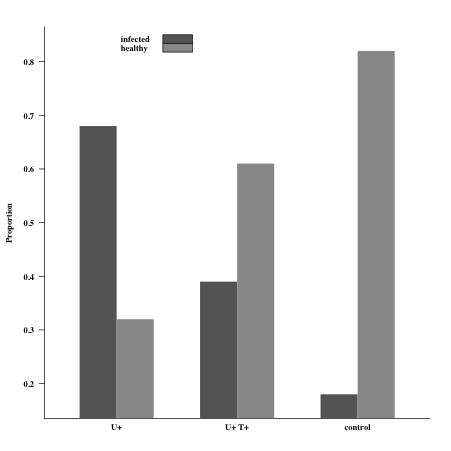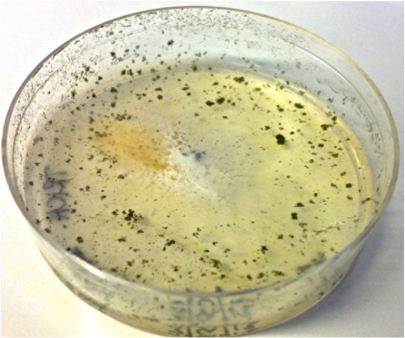
Fungal Species Inhibits Cheatgrass Pathogen
Block title
Despite a high abundance and widespread distribution, the fungal head smut pathogen, Ustilago bullata, exhibits limited control of cheatgrass populations. Previous results indicate other fungal endophytes may interfere with the ability of U. bullata to infect cheatgrass. In fall 2011, we found multiple isolates of fungal endophyte Trichoderma in healthy cheatgrass populations. Adjacent cheatgrass patches with high infection rates of U. bullata contained no evidence of Trichoderma. In a follow up study, plants inoculated with Trichoderma and U. bullata showed an approximately 40% lower infection rate than those inoculated with U. bullata alone (Figure 1).

Figure 1: This chart shows the proportion of plants infected with U. bullata in each treatment. Three treatments were tested: plants inoculated only with U. bullata (U+), plants inoculated with both U. bullata and Trichoderma (U+, T+), and plants inoculated with sterile water (control). A Chi-square test showed that differences in group counts were significant at p < .001 (χ2=51.0763; d.f. = 3).
Trichoderma reaches peak abundance in fall (Widden et al. 1980), when U. bullata first colonizes germinant cheatgrass plants. Trichoderma species parasitize other fungi, produce antifungal compounds, and induce plant defenses against fungal infection (Harman et al. 2004). Trichoderma and other fungi abundant in fall may increase resistance of cheatgrass seedlings to pathogens, promote seedling growth, and influence cheatgrass invasions on a landscape scale. This winter we will use molecular methods to investigate the fungal communities in cheatgrass seedlings and determine if they differ in areas with high U. bullata infection compared to areas that appear healthy.

Picture 1: Trichoderma isolated from cheatgrass plants grows on malt extract agar in the lab.
References:
1. Harman GE, Howell CR, Viterbo A, Chet I, Lorito M. 2004. Trichoderma Species- Opportunistic, Avirulent Plant Symbionts. Nature Reviews, Microbiology. Vol. 2,43-56.
2. Widden P, Abitbol J. 1980. Seasonality of Trichoderma Species In A Spruce-Forest Soil. Mycologia. Vol. 72, 4:775-784



















